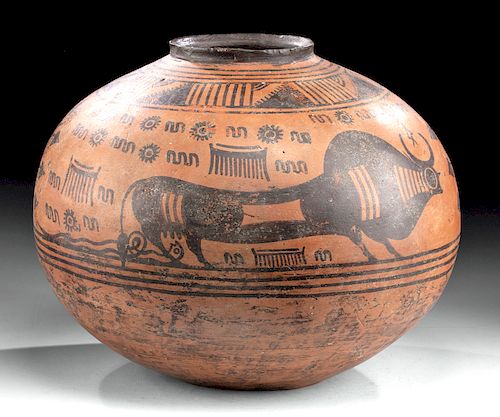Large & Intact Indus Valley Pottery Jar with Bulls
Lot 122a
About Seller
Artemis Fine Arts
686 S Taylor Ave, Ste 106
Louisville, CO 80027
United States
Selling antiquities, ancient and ethnographic art online since 1993, Artemis Gallery specializes in Classical Antiquities (Egyptian, Greek, Roman, Near Eastern), Asian, Pre-Columbian, African / Tribal / Oceanographic art. Our extensive inventory includes pottery, stone, metal, wood, glass and textil...Read more
Categories
Estimate:
$3,000 - $4,500
Absentee vs Live bid
Two ways to bid:
- Leave a max absentee bid and the platform will bid on your behalf up to your maximum bid during the live auction.
- Bid live during the auction and your bids will be submitted real-time to the auctioneer.
Bid Increments
| Price | Bid Increment |
|---|---|
| $0 | $25 |
| $300 | $50 |
| $1,000 | $100 |
| $2,000 | $250 |
| $5,000 | $500 |
| $10,000 | $1,000 |
| $20,000 | $2,500 |
| $50,000 | $5,000 |
| $100,000 | $10,000 |
| $200,000 | $20,000 |
About Auction
By Artemis Fine Arts
Sep 26, 2019
Set Reminder
2019-09-26 10:00:00
2019-09-26 10:00:00
America/New_York
Bidsquare
Bidsquare : Exceptional Day 1: Antiquities & Asian Art
https://www.bidsquare.com/auctions/artemis-gallery/exceptional-day-1-antiquities-asian-art-4437
Day 1 of an important 2-day auction featuring exceptional, museum-worthy examples of Egyptian, Greek, Etruscan, Roman, Viking, Russian, Near Eastern, as well as Asian Art from China, Japan, Thailand, Vietnam, Burma and India. Artemis Fine Arts info@artemisfinearts.com
Day 1 of an important 2-day auction featuring exceptional, museum-worthy examples of Egyptian, Greek, Etruscan, Roman, Viking, Russian, Near Eastern, as well as Asian Art from China, Japan, Thailand, Vietnam, Burma and India. Artemis Fine Arts info@artemisfinearts.com
- Lot Description
Central Asia, Indus Valley civilization, Pakistan (Baluchistan) Mehrgarh style, ca. 3000 to 2500 BCE. An incredibly preserved large ceramic vessel, a round-bodied bowl, wider than it is tall, with a narrow, round mouth and a slightly raised, thin rim. The exterior is painted with a profusion of black-on-red images repeated twice in a register around the upper body: a massive zebu bull with its face nearly eclipsed by its massive, perfectly circular eye, and a tall, symmetrical plant sprouting fertile leaves and berries. Sun symbols and repeated curved lines decorate the spaces between these two images. Several thin black bands encircle the body just below these images, while the shoulder has repeated dense geometric forms: steps, lines, and curves, all concentric and interlocking. This is a masterpiece of decoration, with everything painted by a sure, steady hand. Size: 9.25" W x 8" H (23.5 cm x 20.3 cm)
The Zebu is the domesticated form of the Asian auroch, who was replaced by the Zebu through selective breeding during the time of the Indus Valley civilization. Artistic representations of humped bulls occur throughout the area and it has been theorized by the excavators of Harappa that they symbolize the "leader of the herd", powerful, strong, and virile. It seems likely that this fine ceramic was made in Baluchistan, the region of modern-day Pakistan that borders Iran and Afghanistan. Harappan artistic representations of both animals and humans are renowned for their technical achievements at an early date.
Provenance: private East Coast, USA collection; ex-Japanese private collection, Tomatsu Miura, Tokyo, Japan, 1980s
All items legal to buy/sell under U.S. Statute covering cultural patrimony Code 2600, CHAPTER 14, and are guaranteed to be as described or your money back.
A Certificate of Authenticity will accompany all winning bids.
We ship worldwide and handle all shipping in-house for your convenience.
#149971Intact. Some wear to pigment commensurate with age with a few small chips, nicks, and scratches on surface. Truly in remarkable condition for its age. Rich deposits on interior.Condition
- Shipping Info
-
All shipping is handled in-house for your convenience. Your invoice from Artemis Gallery will include shipping calculation instructions. If in doubt, please inquire BEFORE bidding for estimated shipping costs for individual items.
-
- Buyer's Premium



 EUR
EUR CAD
CAD AUD
AUD GBP
GBP MXN
MXN HKD
HKD CNY
CNY MYR
MYR SEK
SEK SGD
SGD CHF
CHF THB
THB
















